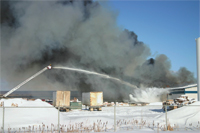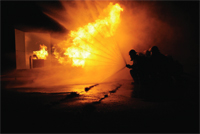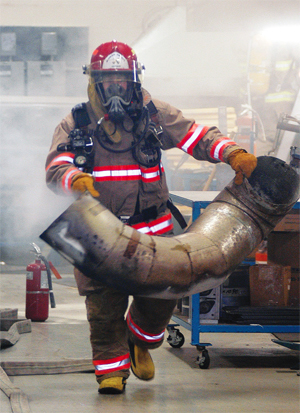
Features
Training
Answering the call: Training for industrial response
Industrial fires can be a firefighter’s worst nightmare. The reason: “The frequency of these events is low in comparison to other fires but the risk to firefighter life safety is higher,” says Jim Bond, deputy fire chief and manager of training at the Surrey Fire Service in B.C.
March 17, 2008
By James Careless
Industrial fires can be a firefighter’s worst nightmare. The reason: “The frequency of these events is low in comparison to other fires but the risk to firefighter life safety is higher,” says Jim Bond, deputy fire chief and manager of training at the Surrey Fire Service in B.C.
“For example, air-management rules that might work well in small structures are not suitable for large structures due to the time required to move within the structure, and if an air alarm is sounding in the middle of a large structure, the firefighter may not have sufficient time to get out safely.”
 |
| Firefighters in Fort St. John, B.C., battle a blaze at a 30,000-square-foot warehouse that stored oilfield chemicals. Firefighters were on scene for more than 12 hours in the -20 C weather on Feb. 12. PHOTO COURTESY CITY OF FORT ST. JOHN FIRE DEPARTMENT |
Industrial fires also usually require different suppression techniques and equipment, he notes.
“Industrial structures tend to be made of different materials and will behave differently under fire conditions. Steel-frame buildings, for example, may afford less time before structural collapse.”
There are ways to mitigate the risks associated with industrial firefighting. Deputy Chief Bond, Stephen McDonald, deputy fire chief (emergency management) for the Regional Municipality of Wood Buffalo in Alberta, and George Quick, assistant director for programs and operations at the University of Nevada, Reno Fire Science Academy, have provided some expert advice on the topic.
Map out industrial fire hazards
“The most important thing you can do is pre-plan the hazards in your jurisdiction,” says Bond. “Work with the industries to identify the dangers and the proper way to handle them. The fire department must have a working relationship with the industries in their jurisdiction.”
Adds Quick: “It is absolutely essential to do pre-planning and to work with the industries. The fire department must rely on the individual industries to provide expertise on the hazards present. Prior to an incident, the roles for both the fire department and the industry must be defined, so all parties know what they are expected to do.”
To do all of this successfully, each fire company needs to contact the industries in its jurisdiction to find out what they do, what materials they have on site and where they are stored. “It is the neighbourhood fire company that should be aggressively involved with tactical walk-about exercises at those industrial properties on a regular basis,” says Bond.
“This proactively affords an opportunity to establish relationships before an emergency, and provides owner/operators to provide specific information that would not be acquired during a regular fire safety inspection. Some facilities may have specialists, possibly chemists or specialty fire brigades. This is an opportunity to make these essential contacts.”

|
| Toronto firefighters approach a gas connection under a wide spray during training for industrial fire fighting. PHOTO BY JOHN RIDDELL |
Prioritize risks
Once a fire company knows the nature of the industries within its territory, “the fire department should consider rules to prioritize those industries that represent the greatest risk to responders or neighbouring populations, and consider also what safety systems have been installed under code provisions to manage those risks,” says Chief Bond.
For instance, “A facility such as a lithium-battery plant might at first be perceived to be at higher risk but dry rooms and strict storage regulations and special extinguishing systems safely manage those risks. Alternatively, a vehicle tire recycling facility may have large stockpiles of rubber with little fire protection for outdoor storage.”
Planning
OK, the risks have been assessed and priorities assigned. The next stage is to plan the department’s best response to likely incidents, in tandem with the industries and their own fire-suppression crews. Site attack, personnel protection and population evacuation tactics should be worked out at this stage and co-ordinated with the necessary agencies, as should “a well-known ICS system for command and control,” says Bond. “This system should be known by all emergency response services due to their likely involvement.”
Training
Once the plans are in place, industrial fire training must begin. “Tabletop, on-site drills and exercises ensure that department members know the hazards and the proper actions to take at individual facilities,” says Quick. This particularly applies to hazmat teams.
 |
| Capt. Danny Young removes a section of duct work cut from the ceiling of a filter-manufacturing plant in Waterloo, Ont., after it caught fire and forced the evacuation of employees. PHOTO BY MIKE GIFFORD
|
“Like any specialty team, they must have a regular training program to maintain their skills,” he says. “This training will be based on the actions they will be expected to take at a scene. In large scale industrial incidents this usually involves research and planning more than mitigation. Do not forget the basics: containment, damming and diking.”
“Train them, test them and train them again,” adds Deputy Chief McDonald. Among the skills he ranks as most important are big water delivery, live fire training (hydrocarbon), tank farm setup and
mutual aid.
Worth noting: If your industrial firefighting plans call on multi-agency participation then these agencies must take part in your training and drills.
Essential tools
What tools should you have at hand to fight industrial fires? “This depends on the hazards that are identified in the pre-planning phase,” replies Quick. “Some common items are high-volume foam proportioning equipment and foam concentrate (preferably in totes) mounted on a trailer to allow a single person to bring it to the scene using a pick-up truck. The foam needs to be appropriate to the hazards but typically an alcohol resistant AFFF is the best all-around foam.
McDonald endorses Quick’s advice, but adds that two other important industrial firefighting tools are “large diameter hoses and water delivery devices.”
Quick recommends a high-capacity portable monitor while Bond says a thermal-imaging camera is a must. “This tool can help the responders determine the extent of the problem under heavy smoke conditions and provides initial important size-up information.”
On-scene tactics
The risk has become reality: Your department is on scene at an industrial fire. Should you go in and attack? No, says Quick. “Industrial fires should be fought in a defensive manner until all the hazards are identified.”
“The priority has to be life safety and then containing the incident, which includes run-off,” he explains. “Only once all the hazards are identified and a plan is developed to address these hazards the department can begin offensive operations. But if the results will be the same whether offensive or defensive operations are selected, then put responders at the lowest risk by remaining in a defensive mode.”
Adds McDonald, “Take the time to assess the situation prior to committing resources.”
When it comes to keeping personnel safe while fighting an industrial fire the most effective protective option is to use distance, says Quick. This is why “the use of high flow monitors which allow firefighters to remain as far away from the actual fire as possible is recommended in many cases.”
Starve the fire
In a typical residential fire, officers do their best to douse the flames. But this tactic is not necessarily appropriate in industrial situations. In fact, “The best way to fight most industrial fires is to protect exposure, shut off the flow of fuel or remove unburned material from the fire area and allow the fire to self-extinguish,” says Quick. In other words, contain and then starve an industrial fire; don’t risk your staff in unnecessary heroics.
The experts’ best advice
Our experts have covered many aspects of industrial firefighting. So what is the one point that they consider to be most important?
“The best advice is to work with the industries in your area and develop comprehensive pre-plans,” says Quick. “Do not assume they have the specialized equipment necessary to handle an incident at their facility. Look outside your jurisdiction for expertise, equipment and assistance; do not try to do it all by yourself.”
Adds Bond: “Know the characteristics of the product and structure under fire conditions and do not risk firefighter lives to save property alone.”
Print this page
Advertisement
- Fire chief paid less than police service head
- Cracking down: Software helps communities locate grow ops and reduces threat to public safety